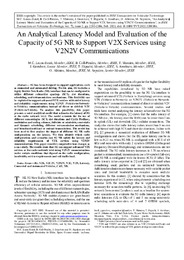Título :
An Analytical Latency Model and Evaluation of the Capacity of 5G NR to Support V2X Services Using V2N2V Communications |
Autor :
Lucas-Estañ, M. Carmen 
Coll-Perales, Baldomero 
Shimizu, Takayuki 
Gozalvez, Javier 
Higuchi, Takamasa 
Avedisov, Sergei 
Altintas, Onur 
Sepulcre, Miguel  |
Editor :
IEEE |
Departamento:
Departamentos de la UMH::Ingeniería de Comunicaciones |
Fecha de publicación:
2022-09 |
URI :
https://hdl.handle.net/11000/30152 |
Resumen :
5G has been designed to support applications such as connected and automated driving. To this aim, 5G includes a highly flexible New Radio (NR) interface that can be configured to utilize different subcarrier spacings (SCS), slot durations, scheduling, and retransmissions mechanisms. This flexibility can be exploited to support advanced V2X services with strict latency and reliability requirements using V2N2V (Vehicle-to-Network-to-Vehicles) communications instead of direct or sidelink V2V (Vehicle-to-Vehicle). To analyze this possibility, this paper presents a novel analytical model that estimates the latency of 5G at the radio network level. The model accounts for the use of different numerologies (SCS, slot durations and Cyclic Prefixes), modulation and coding schemes, full-slots or mini-slots, semi-static and dynamic scheduling, different retransmission mechanisms, and broadcast/multicast or unicast transmissions. The model has been used to first analyze the impact of different 5G NR radio configurations on the latency. We then identify which radio configurations and scenarios can 5G NR satisfy the latency and reliability requirements of V2X services using V2N2V communications. This paper considers cooperative lane changes as a case study. The results show that 5G can support advanced V2X services at the radio network level using V2N2V communications under certain conditions that depend on the radio configuration, bandwidth, service requirements and cell traffic load.
|
Palabras clave/Materias:
5G, V2X, V2C2V, V2N2V, V2C, V2N, Latency, Connected and Automated Vehicles, CAV, NR.
V2X
V2C2V,
V2N2V
V2C
V2N
Latency
Connected and Automated Vehicles
CAV
NR |
Área de conocimiento :
CDU: Ciencias aplicadas: Ingeniería. Tecnología: Ingeniería mecánica en general. Tecnología nuclear. Electrotecnia. Maquinaria: Ingeniería eléctrica. Electrotecnia. Telecomunicaciones |
Tipo documento :
application/pdf |
Derechos de acceso:
info:eu-repo/semantics/openAccess
Attribution-NonCommercial-NoDerivatives 4.0 Internacional |
DOI :
https://doi.org/10.1109/TVT.2022.3208306 |
Aparece en las colecciones:
Artículos Ingeniería Comunicaciones
|
 La licencia se describe como: Atribución-NonComercial-NoDerivada 4.0 Internacional.
La licencia se describe como: Atribución-NonComercial-NoDerivada 4.0 Internacional.
.png)
